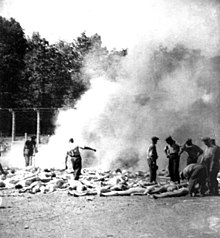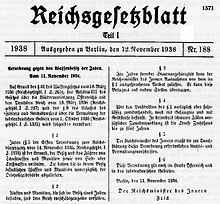The Holocaust
![]()
Shoa is a redirect to this article. For other meanings, see Holocaust (disambiguation) and Shoa (disambiguation).
As Holocaust [ˈhoːlokaʊ̯st, holoˈkaʊ̯st] (English, from ancient Greek ὁλόκαυστος holókaustos "completely burned"; also Schoah or. Schoa, in English transcription Shoah or Shoa; Hebrew הַשּׁוֹאָה ha'Schoah for "the catastrophe", "the great misfortune/disaster") is mostly used today to refer to the Nazi genocide of 5.6 to 6.3 million European Jews. Germans and their helpers carried it out systematically from 1941 to 1945, from 1942 also with industrial methods, with the aim of murdering all Jews in the German sphere of power. This crime against humanity was based on the anti-Semitism propagated by the state and the corresponding racist legislation of the Nazi regime. In Nazi ideology, the genocide of the Jews since the invasion of Poland was justified as the "extermination of life unworthy of life" and placed on a par with the Nazi murders of the sick in "Aktion T4" and "child euthanasia". The final decision to murder all Jews was made in close connection with the war of extermination against the USSR starting in the summer of 1941.

Burning of corpses by the Sonderkommando KZ Auschwitz-Birkenau, photographed by Alberto Errera, August 1944

Photo of the gatehouse of the Auschwitz-Birkenau concentration camp. Taken from the train ramp inside the camp by Stanisław Mucha, February/March 1945.
Designations
→ Main article: Holocaust (term)
Since 1940, the National Socialists officially called their goal of expelling all Jews from Europe the "Final Solution of the Jewish Question". From 1941 onwards, this term was used as a camouflage to describe their systematic murder of Jews. It is often quoted in historical works about it. The term "resettlement", which was frequently used outwardly, also served to disguise the Nazi crimes.
In the German-speaking world, genocide (or democide) has been referred to since May 1945 as Judenvernichtung, Judenmord or mass murder of the European Jews. As a result of the first Auschwitz trial in Frankfurt, Auschwitz, the name of the largest National Socialist extermination camp (Auschwitz-Birkenau concentration camp), also became established since 1963 as a symbolic designation for the entire event.
The term holocaust, in common use today, derives from the Greek adjective ὁλόκαυστον (holókauston), meaning "completely burned" and denoting an animal sacrifice completely burned on altars. From about 1600, the English word holocaust also referred to fiery deaths, and from about 1800 to massacres, and from 1895 to ethnic massacres such as the later Armenian genocide. The British newspaper News Chronicle first used the word for Adolf Hitler's extermination plan against the Jews in December 1942, but still without knowledge of the Nazi methods of extermination. By 1972 it had become common in United States historiography for it. Beginning in 1978, the television series Holocaust - The Story of the Weiss Family spread it to many other countries, including the Federal Republic of Germany. Since then, the term has usually been limited to the systematic murder of European Jews. Sometimes it also includes the Porajmos, the genocide of several hundred thousand Roma, whom the National Socialists also declared "Gypsies" to be an "inferior alien race" and wanted to exterminate. Only rarely is it referred to the entire National Socialist extermination policy.
The designation of the extermination of the Jews as the "Holocaust" has often been considered problematic because of the word's origin in the religious cult of sacrifice and its earlier use in Christian anti-Judaism. In Israel and Judaism, the crime has been referred to as the Shoa ("catastrophe", "great calamity") since 1948. It has been commemorated since 1959 by the memorial day Yom haSho'a. Since 1985, the Hebrew word has also been used in Europe for the Holocaust. Jewish theologians sometimes refer to the event as the third churban (Hebrew: "destruction", "devastation") and thus interpret it, like the two destructions of the Jerusalem Temple (586 B.C. and 70 A.D.), as a major catastrophe affecting all descendants of the Israelites, i.e. all Jews.
"Crimes against humanity", "war crimes", "genocide" and "Holocaust" are often mistakenly used as synonyms. The first three terms are legal concepts that are also scientific categories.
- "Crimes against humanity" are broad-based or systematic attacks on civilian populations. In international law, they constitute an umbrella term under which both "war crimes", "crimes against peace", and "genocide" fall.
- War crimes are criminal acts committed during an armed conflict, in particular in violation of the Geneva Conventions.
- Genocide is the coordinated and planned destruction of a group of people, with this "group" being defined by the perpetrators.
See also: Genocides in history
Previous story
The historical preconditions of the Holocaust include modern anti-Semitism, which emerged in Europe from around 1870 and in turn had a long prehistory in Christian anti-Judaism. The conditions for the emergence and rise of National Socialism include above all the First World War of 1914-1918 and the Great Depression of 1929-1932.
Goals of National Socialism
With its 25-point program, the NSDAP, founded in 1919, aimed at the exclusion and expulsion of the Jews from the German "national community". Adolf Hitler had already declared the "removal of the Jews altogether" as the political goal of such a state in 1919, before joining the party. In an interview with a Catalan journalist in November 1923, he declared that killing all the Jews of Germany "would of course be the best solution." But since this was not possible, the only solution left was mass expulsion. In his two-part programmatic pamphlet Mein Kampf (1925/1926) as well as his unpublished Second Book (1928), he elaborated on his racial anti-Semitism, advocated mass murder of Jews in the event of a new world war, and declared the annihilation of "Jewish Bolshevism" to be the main goal of National Socialist foreign policy. What was meant was the warlike conquest of the Soviet Union, dominated by an alleged "world Jewry", and the subsequent Germanization through mass resettlements and mass murders.
The consistent, fanatical "redemptive anti-Semitism" of Hitler and his followers (a coinage of Saul Friedländer's term) is considered an essential, but not the sole and sufficient condition for the Holocaust.
Persecution of Jews in the German Reich 1933-1939
→ Main article: Section "Persecution of Jews 1933-1938" in the article "National Socialist era".
By 1941, the National Socialists were striving for the expulsion and expropriation of German Jews. Immediately after Hitler's accession to power on January 30, 1933, the NSDAP and its sub-organizations SA, SS, NSDStB and Hitler Youth began with partly unplanned, partly organized acts of violence against Jews. A state "Judenpolitik" emerged only as a reaction to this. Important milestones were the "boycott of Jews" of April 1, 1933, and the Law for the Restoration of the Professional Civil Service of April 7, 1933, which provided for the dismissal of all "non-Aryan" civil servants and thus introduced a racial criterion into a state law for the first time. It initiated the social exclusion of Jews from professional associations, businesses, clubs, schools, and cultural life. This continued with numerous other anti-Jewish laws and decrees, and was constantly intensified until 1945. Also in 1933, concentration camps (KZ) were established, mostly under the direction of the SA. Initially, political opponents were imprisoned. The Dachau concentration camp, run by the SS, became a model for later labor and extermination camps for Jews and other racially persecuted groups. Starvation, torture and arbitrary murder were part of everyday life in the first concentration camps. Jewish camp inmates were already particularly harassed there and had the highest mortality rates. On April 12, 1933, Jews were murdered in Dachau concentration camp for the first time, e.g. Rudolf Benario, and six months later the murder of concentration camp inmates was legalized by means of the "Postenpflicht".
In the summer of 1935, the NSDAP party base again organized boycott actions. In response, the Nazi regime hastily enacted the Nuremberg Laws in September, which severely restricted the civil rights of German Jews. "Volljuden" (full Jews) and "jüdische Mischlinge" (Jewish half-breeds) were defined in ordinances that were later subsequently issued. Gentiles who married a Jew or a Jewess or converted to the Jewish religion were declared "Geltungsjuden" regardless of their origin. In 1936 and 1937 Hitler hardly talked about Jews and took no further initiatives for their complete expulsion. But on November 30, 1937, according to Joseph Goebbels, he affirmed, "The Jews must get out of Germany, indeed out of all Europe." This would take time, but he was "firmly resolved" to do so. In 1938, parallel to the ongoing rearmament of the Wehrmacht and preparations for war, the Nazi regime again intensified the persecution of Jews. For example, they had to take on additional "typically Jewish" first names and surnames (January), were robbed en masse after the annexation of Austria (March), had to "declare" all their assets (April 26), were no longer given state contracts and licenses to practice medicine (September), but were given a Jewish stamp in their passports (October), which was justified by foreign measures against Jewish emigrants. Jews without a "typical Jewish" name had to additionally adopt the name "Sara" for women and "Israel" for men due to the name change ordinance in August 1938.
In the "Polish Action" of October 27, 1938, some 15,000 Jews were forcibly deported from Germany to Poland. The murder of the German diplomat Ernst vom Rath by the person concerned, Herschel Grynszpan, served as a welcome pretext for the Reich-wide November pogroms of 1938, during which some 400 people were murdered, over 1,400 synagogues, other meeting halls and cemeteries were destroyed and up to 36,000 Jews were interned in concentration camps. With the "Judenbuße" imposed on November 12, the victims had to pay for the destruction; with the decree for the elimination of Jews from German economic life and the decree on the use of Jewish property, the state "Aryanization" was accelerated. Even without a "fundamental plan," the Nazi regime's measures created essential administrative conditions that made the Holocaust possible: including the legal definition of the term "Jew," expropriation, and concentration in special housing areas. National Socialist persecution and murder of the Jews are therefore described as interlocking, inseparable "extermination policies".
Of 510,000 German Jews who had joined the Israelite religious communities in 1933, 278,000 to 315,000 emigrated by the beginning of the war in September 1939; by 1940 another 15,000 had fled. In October 1941 the National Socialist leadership imposed a ban on emigration for Jews. Of Jews living in "mixed marriages" or in hiding in the Reich, 10,000 to 15,000 escaped the Holocaust. Up to 195,000 German Jews were murdered in them. About 6000 survived the camps. Of about 200,000 Austrian Jews, about 65,500 were killed during the Nazi era; the rest were able to flee after the Anschluss and the beginning of the war.

German Reich Law on the Disarmament of Jews (November 12, 1938)
Questions and Answers
Q: What was the Holocaust?
A: The Holocaust was a genocide in which Nazi Germany systematically killed people during World War II.
Q: How many Jews were killed during the Holocaust?
A: About twelve million Jews were killed during the Holocaust.
Q: Who were the other groups that the Nazis killed besides Jews?
A: The other groups that the Nazis killed were mostly Slavs, communists, Roma people, people with disabilities, homosexuals, and Jehovah's Witnesses.
Q: How did the Nazis kill their victims?
A: The Nazis killed their victims by rounding them up, putting them in ghettos, forcing them to work in concentration camps, and then killing them in gas chambers.
Q: What was the yellow Star of David?
A: The yellow Star of David was a symbol of the Jewish religion that Jews were forced to wear during the Holocaust.
Q: What is another name for the Holocaust?
A: Another name for the Holocaust is The Shoah, which is the Hebrew word for catastrophe or calamity.
Q: How many total people were killed during the Holocaust?
A: About twelve million Jews and five million others were killed during the Holocaust.
Search within the encyclopedia